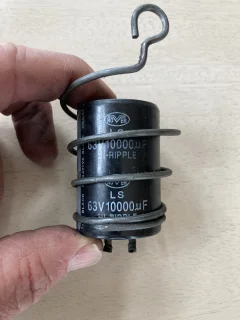- Joined
- Mar 25, 2023
- Messages
- 39
I just installed Amal Premiers, new fuel and lines, but still having a hard time starting the bike (many, many, kicks) and getting it to run/idle when going. I was looking for electrical problems/answers and found this thing (picture attached) under my seat with a frayed wire unattached. I also found a Sparx voltage regulator next to it, which I understand replaces the Zener diode, capacitor, and rectifier that I see on my wiring diagram. Any idea what this is and if I need it?
Also, I have conducted some tests on my 6v coils with the following results:
Right coil primary to primary: 1.9 ohms (a little low?)
Left coil primary to primary: 2.2 ohms (ditto?)
Right coil primary to center core of coil: open circuit/infinite
Left coil primary to center core of coil: 5.4 K ohms (problematic?)
Left coil center core of coil to right coil center core of coil: 10.8 K ohms (test was repeated reading at end of plug wires and reproduced the same value)
Could this be producing weak spark or am I looking in the wrong place?
Thanks
Also, I have conducted some tests on my 6v coils with the following results:
Right coil primary to primary: 1.9 ohms (a little low?)
Left coil primary to primary: 2.2 ohms (ditto?)
Right coil primary to center core of coil: open circuit/infinite
Left coil primary to center core of coil: 5.4 K ohms (problematic?)
Left coil center core of coil to right coil center core of coil: 10.8 K ohms (test was repeated reading at end of plug wires and reproduced the same value)
Could this be producing weak spark or am I looking in the wrong place?
Thanks

